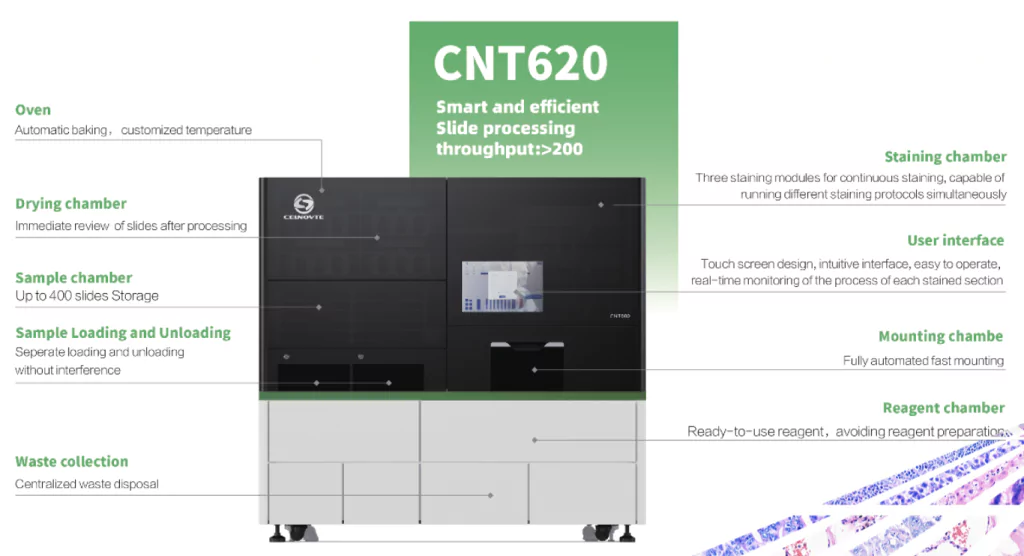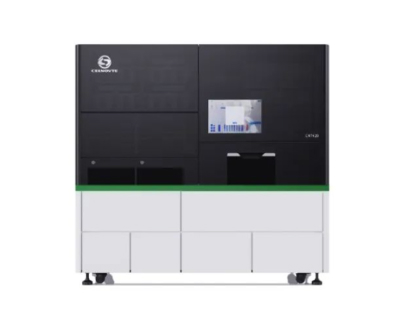Discover the Key Benefits of a Fully Automatic H&E Stainer

By admin
Histopathology relies heavily on the Hematoxylin and Eosin (H&E) staining method to observe structures and abnormalities. The importance of H&E staining cannot be emphasized enough as it offers insights, into tissue structure and plays a role in accurate disease diagnosis and research. This staining technique enables pathologists to distinguish between tissue components thereby aiding in making informed clinical judgments. Furthermore following protocols, for H&E staining is essential to ensure reliable results that adhere to the high standards of histopathological evaluations.
H&E Staining: Importance and Practices
The Role of H&E Staining in Histopathology
Hematoxylin and eosin (H&E) staining is a technique, in histopathology for examining tissue structure. When viewed through a microscope stained slides help analyze cell details, which is crucial for diagnosing diseases like cancer. By using hematoxylin to color nuclei blue and eosin to color cytoplasm pink pathologists can differentiate between cell components easily. This visual distinction plays a role, in recognizing cancers, inflammatory conditions, and other diseases highlighting the importance of H&E staining in both settings and research environments.
Best Practices for Consistent Staining Results
To ensure consistent outcomes, in H&E staining it is important to follow established guidelines. These guidelines encompass using procedures for preparing and handling tissue samples maintaining levels of reagents and carefully timing each stage of the staining process. It is crucial to calibrate equipment and implement quality control checks to reduce variability and enhance the reproducibility of results. Adhering to these recommended practices can greatly enhance the accuracy of assessments, in laboratories leading to improved care.
Comparing Manual and Automatic H&E Staining Methods
Challenges of Manual H&E Staining
Many labs still use H&E staining, which comes with its set of challenges. One major issue is the risk of lab technicians developing strain injuries from the repetitive tasks involved in the staining process. These injuries can reduce efficiency. Increased instances of absence ultimately affect how labs operate. Moreover, mistakes made by humans can introduce variations, in staining results potentially impacting the precision of analyses.
Repetitive Strain and Injuries in Lab Technicians
The repeated movements required in performing H&E staining can cause strain and injuries, with prolonged exposure. Methods that demand manipulation and frequent handling or transferring of slides raise the likelihood of problems, among lab workers. This physical burden does not impact the health of employees. Also influences the overall effectiveness of lab activities.
Inconsistencies in Results Due to Human Error
Manual techniques also result in variations, in staining results. Because each technician employs methods the outcomes of H&E staining can differ significantly. This lack of uniformity may cause misreading of discoveries potentially affecting patient diagnoses and treatment strategies negatively. Consequently, assessment reliability is compromised when dependent, on manual procedures.
How Automatic Stainers Mitigate These Issues
Automatic H&E stainers present a solution to many of the challenges posed by manual staining methods. By automating the process, these machines help to eliminate the manual handling of samples, thereby reducing the risk of repetitive strain and injury. Additionally, automation standardizes the staining procedure, ensuring that every sample receives the same treatment, which significantly mitigates the risk of human error. As a result, labs utilizing automatic stainers can maintain a higher level of quality control and consistency in their staining results.
Features and Advantages of a Fully Automatic H&E Stainer
Time Efficiency in Laboratory Workflows
One of the most significant advantages of a fully automatic H&E stainer is the time efficiency it introduces into laboratory workflows. These systems can process multiple samples simultaneously, drastically reducing turnaround times for staining procedures. For instance, modern machines can complete multiple staining cycles while maintaining high throughput, enabling laboratories to handle larger volumes of samples with minimal delay.
Reduction in Turnaround Times
With the capability to automate the staining process, laboratories can significantly shorten the turnaround time necessary to evaluate samples. Faster processing means quicker diagnostic results for patients, which is a critical component in healthcare settings, particularly in oncological cases where timely intervention is paramount. Optimizing the workflow allows teams to devote more time to interpretation and less time to practical staining procedures.
Enhanced Throughput with Parallel Processing
The parallel processing feature of fully automatic H&E stainers elevates the productivity of histopathology laboratories. By handling multiple samples at once, these automated systems can provide a continuous workflow that manual methods cannot match. This enhanced throughput is crucial in high-demand environments, allowing labs to scale operations without compromising quality.
Economic and Environmental Benefits
Beyond time savings, fully automatic H&E stainers also present economic advantages. The efficiency of these machines results in a more prudent use of reagents, thereby contributing to cost savings over time. By automating the staining process, laboratories can reduce their overall staining costs by minimizing reagent waste, which is often the result of manual pouring and mixing.
Reagent Efficiency and Cost Savings
Cost savings manifest in various forms, one of which is reagent efficiency. Fully automated H&E stainers utilize precise dosing mechanisms, ensuring that the right amount of staining solution is used for each sample. This precision minimizes waste, which not only saves money but also reduces the environmental footprint associated with excess chemical disposal.
Waste Reduction Strategies
Waste reduction is another critical environmental benefit associated with fully automatic H&E stainers. By employing systems designed for optimal reagent utilization and by reducing the physical handling of solute materials, laboratories can not only cut down on costs but also lessen their overall environmental impact. These machines help foster a more sustainable laboratory practice, aligning operational efficiencies with ecological responsibility.
In summary, the transition to a fully automatic H&E stainer represents a significant advancement in the histopathology field. Its advantages extend across operational efficiency, cost-effectiveness, and enhanced quality control, ultimately leading to better patient outcomes in clinical settings. As laboratories strive for excellence, fully automatic H&E stainers are becoming an integral component in the pursuit of high-quality histological diagnostics.
Insights into CNT 620 Fully Automatic HE Drip-stainer and Coverslipper
About Celnovte
Celnovte is a reputable manufacturer specializing in advanced laboratory technologies for histopathology and other biological sciences. With a commitment to innovation and quality, Celnovte aims to support clinical laboratories in optimizing their workflows and enhancing diagnostic outcomes. Its state-of-the-art products cater to the evolving needs of the medical community, providing tools like IHC stainer, cytology stainer, and H&E stainer that streamline processes while ensuring accuracy and reliability. Among its distinguished offerings is the CNT 620 Fully Automatic HE Drip-stainer and Coverslipper, which represents a significant leap in automation technology for histology laboratories.
CNT 620 Fully Automatic HE Drip-stainer and Coverslipper
Presenting the CNT 620, a groundbreaking Fully Automatic HE Drip-stainer and Coverslipper that revolutionizes workflow efficiency with its seamless design. Ensuring absolute cross-contamination prevention, this system boasts freshly dispensed reagents for unparalleled staining excellence, reaching an impressive throughput of over 200 slides per hour.
Featuring independent loading and unloading capabilities, the CNT 620 effortlessly accommodates diverse sample volumes, enhancing overall productivity. Its innovative photosensitive design safeguards sample integrity, while its swift processing time of 5-10 seconds per slide accelerates results delivery.
Equipped with advanced protocol tracking functionality, the CNT 620 ensures traceability, minimizing errors, and guaranteeing reproducibility in every run. Ready-to-use reagents streamline operations, eliminating the need for manual preparation, and further simplifying the process.
Closed pipelines guarantee containment, setting a new benchmark for high-throughput staining systems. The CNT 620 embodies the perfect blend of accuracy, speed, and reliability, redefining the standards in the field.
The Broader Scope: Automation Beyond H&E Staining
Advancements in Immunohistochemistry Automation
As laboratories continue to evolve, the automation landscape extends beyond traditional H&E staining into the realm of immunohistochemistry (IHC). Fully automated systems, such as Celnovte’s offerings, can easily transition from H&E staining to IHC, increasing versatility for histopathological evaluations. The CNT 620 is compatible with various immunostaining protocols, enhancing throughput without sacrificing the quality of results.
Significant advancements in IHC automation technologies have resulted in systems capable of managing complex workflows with remarkable accuracy. These devices not only allow for a higher sample throughput but also improve the reproducibility of IHC results, which is crucial for reliable diagnostic conclusions. Additionally, machines that incorporate advanced algorithms can facilitate multi-color immunohistochemistry, significantly expanding the capabilities of laboratories.
Automation, in IHC can also aid technologies like chromogenic in situ hybridization (CISH) using tools such as the CNT 620. Simplifying processes linked to these methods enables diagnosis and enhances patient care strategies highlighting the significance of automation, in modern histopathology.
Benefits Extending to Various Laboratory Techniques
Automated systems offer benefits that go beyond H&E staining and IHC extending to a range of other laboratory techniques and reshaping the standards of histopathology. By their nature automation decreases the chances of mistakes leading to improved consistency, in staining procedures. As a result, labs transitioning to automated setups can anticipate enhancements, in data reliability and diagnostic certainty.
Furthermore, these systems make it easier to manage processes that involve types of stains. This enables labs to expand their testing options without having to undergo retraining or restructuring of procedures. The smooth incorporation of automation, for methods, improves the overall efficiency of the laboratory and simplifies the learning process, for both pathologists and technicians.
Automation also creates a work environment that enhances employee productivity. When the handling of samples and reagents is reduced lab workers can concentrate on analytical duties boosting motivation and involvement. This change has an effect, on lab operations. Promotes a broader perspective, in histopathological analyses.
Conclusion
In summary, the increasing use of automation, in laboratory procedures incorporating technologies such as the CNT 620 highlights the significance of embracing modern approaches in histopathology. Companies like Celnovte that opt for automated staining systems can anticipate improvements in operational productivity, diagnostic precision, and overall patient results. The transition to automation in histopathology goes beyond a fad; it represents an advancement, in healthcare and scientific testing that will shape the future of this field.
RELATED PRODUCTS









